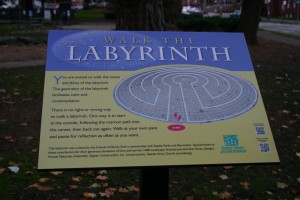Each month in our Open Voices blog we share insight from leaders in our communities who are advancing what it means to have sacred, open green spaces in our cities. This December we introduce sacred spaces that serve as centers for community; spaces to experience the “civic sacred”.
A meditative moment in a walking labyrinth can bring a surprising amount of peace. A walking labyrinth is a circular path, usually set in stone on the ground, that doubles back on itself and leads to a center point. The history of these designs reach back 4000 years ago to Greece and are known to exist in diverse cultures throughout time. The use of these designs as a meditative practice exist in Christian culture, but other religions and secular groups have used them for centuries to contemplate personal truths.

In Seattle, a labyrinth lies in wait in Denny Park– an urban park in the midst of the sprawling Amazon campus. TKF recently spoke with Jackie Roberts, the impetus in installing this community space a few years ago. She is not a landscape architect or park employee, but someone who used her project management skills to address a need and a possibility. Someone who the TKF Foundation might describe as a Firesoul.
During a church picnic at Denny Park, Jackie was awed in the presence of the powerful, enveloping trees and the history of the space. She knew the healing powers of meditative walking first hand and wanted to share this experience with others. Thus started a series of talks and consultations with her church leader, a Mercer Island labyrinth designer, the Pacific Northwest representatives of the Labyrinth Society, South Lake Union businesses, and Friends of Denny Park. She met a landscape architect who enthusiastically agreed to help pro-bono. She was blessed with paver donations and affordable construction. This all came out of talking, meeting and collaborating with others about her idea.
During the planning and development process, Jackie’s husband became tragically quadriplegic. For Jackie, the two and half year process to complete the labyrinth was a personal healing process akin to walking a labyrinth itself.

The labyrinth is open for use by nearby office workers, children in the adjacent playground, those with differing mobility needs (her husband tested it in his wheelchair), even tether ball and tai-chi.
Jackie believes the next step for the meditative space is
“… show local users why they should use it. Show them how and why to take a break from their busy schedule. It is a good respite spot for only 30 minutes. The trees are so old and graceful, people should see them.”
The majority of nearby workers are from Amazon and health research facilities. Jackie wants these Seattle residents and commuters to know there is a place waiting for them to take a break from work stress and the everyday routine.
To visit walking labyrinths nearby you refer to the World Wide Labyrinth Locator.
